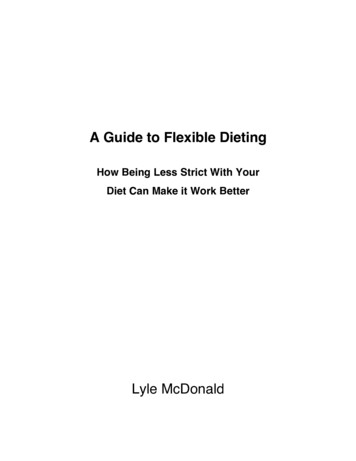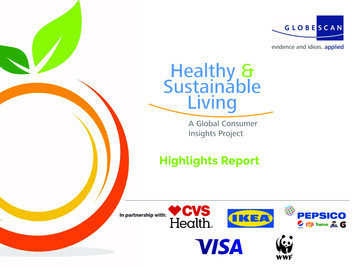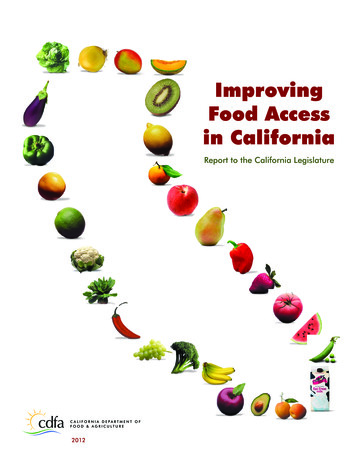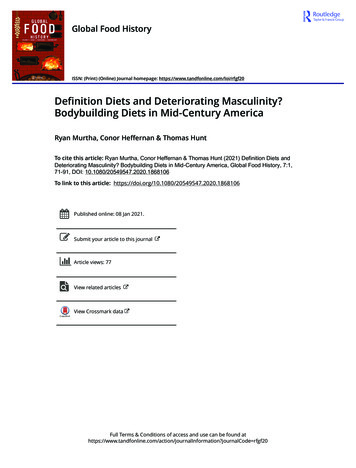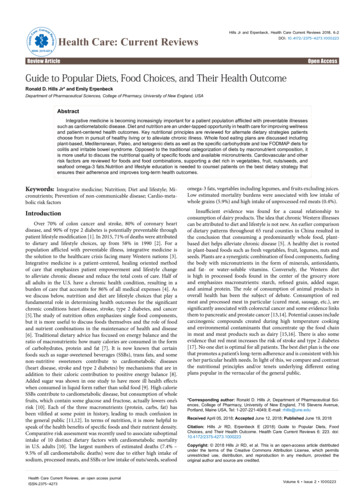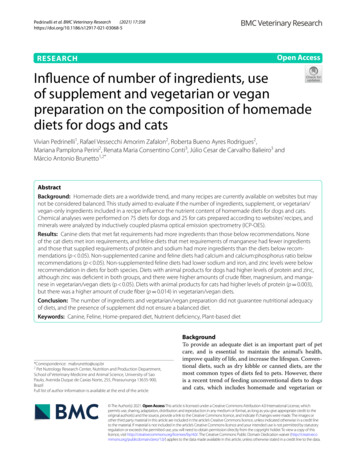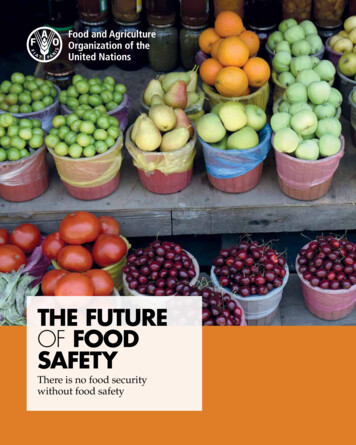
Transcription
Summary Report of the EAT-Lancet CommissionHealthy Diets FromSustainable Food SystemsFoodPlanetHealth
Table of Contents04Introduction06The 1 Goal08The 2 Targets20The 5 Strategies26Conclusion27Glossary28The EAT-Lancet Commission30About EATPhoto credit: Shutterstock (page 8, 20, 22, 24, 25), iStock (page 6), Mollie Katzen (page 11).This report was prepared by EAT and is an adapted summary of the Commission Food in The Anthropocene:the EAT-Lancet Commission on Healthy Diets From Sustainable Food Systems. The entire Commission can befound online at thelancet.com/commissions/EAT.The EAT-Lancet Commission and this summary report were made possible with the support of Wellcome Trust.
Summary ReportProf. Walter Willett MDHarvard T.H. Chan School of Public HealthTransformation to healthy dietsby 2050 will require substantialdietary shifts. Global consumptionof fruits, vegetables, nuts and legumeswill have to double, and consumptionof foods such as red meat and sugarwill have to be reduced by more than50%. A diet rich in plant-based foodsand with fewer animal source foodsconfers both improved health andenvironmental benefits.3
HealthyDiets From Sustainable Food SystemsIntroductionOur Food in theAnthropocene:Healthy DietsFrom SustainableFood SystemsWithout action, the world risks failing to meet the UNSustainable Development Goals (SDGs) and the ParisAgreement, and today’s children will inherit a planet thathas been severely degraded and where much of thepopulation will increasingly suffer from malnutrition andpreventable disease.#foodcanfixit4
Summary ReportFood is the single strongest lever to optimize humanhealth and environmental sustainability on Earth.However, food is currently threatening both peopleand planet. An immense challenge facing humanity is to provide a growing world population withhealthy diets from sustainable food systems. Whileglobal food production of calories has generally keptpace with population growth, more than 820 millionpeople still lack sufficient food, and many moreconsume either low-quality diets or too much food.Unhealthy diets now pose a greater risk to morbidity and mortality than unsafe sex, alcohol, drug andtobacco use combined. Global food production threatens climate stability and ecosystem resilience andconstitutes the single largest driver of environmentaldegradation and transgression of planetary boundaries. Taken together the outcome is dire. A radical transformation of the global food system isurgently needed. Without action, the world risksfailing to meet the UN Sustainable Development Goals(SDGs) and the Paris Agreement, and today’s childrenwill inherit a planet that has been severely degradedand where much of the population will increasinglysuffer from malnutrition and preventable disease.The Commission focuses on two “end-points” of theglobal food system: final consumption (healthy diets) and production (sustainable food production, seeFigure 1). These factors disproportionately impacthuman health and environmental sustainability. TheCommission acknowledges that food systems haveenvironmental impacts along the entire supply chainfrom production to processing and retail, and furthermore reach beyond human and environmental healthby also affecting society, culture, economy, and animalhealth and welfare. However, given the breadth anddepth of each of these topics, it was necessary to placemany important issues outside the scope of the Commission.HealthbosariednousysteFoodPlanetaryFood is the single strongest leverto optimize human health andenvironmental sustainability on Earth.sriedaunbThere is substantial scientific evidence that linksdiets with human health and environmentalsustainability. Yet the absence of globally agreedscientific targets for healthy diets and sustainablefood production has hindered large-scale and coordinated efforts to transform the global food system.To address this critical need, the EAT-Lancet Commission convened 37 leading scientists from 16 countriesin various disciplines including human health, agriculture, political sciences and environmental sustainability to develop global scientific targets for healthydiets and sustainable food production. This is the firstattempt to set universal scientific targets for the foodsystem that apply to all people and the planet.mFigure 1An integrated agenda for food in the Anthropocene recognizes that food forms an inextricable link between human health andenvironmental sustainability. The global food system must operate within boundaries for human health and food productionto ensure healthy diets from sustainable food systems for nearly 10 billion people by 2050.5
HealthyFrom SustainableFood Systems1 Goal Diets– 2 Targets– 5 StrategiesTo AchievePlanetary HealthDiets for Nearly10 Billion Peopleby 2050#foodcanfixit6
Summary ReportA large body of work has emerged on the environmental impacts of various diets, with most studiesconcluding that a diet rich in plant-based foodsand with fewer animal source foods confers bothimproved health and environmental benefits.Overall, the literature indicates that such diets are“win-win” in that they are good for both people andplanet. However, there is still no global consensus onwhat constitutes healthy diets and sustainable foodproduction and whether planetary health diets*may be achieved for a global population of 10 billion people by 2050.SELOSINLOO-LThe boundaries of the safe operating space are placedat the lower end of the scientific uncertainty range,establishing a "safe space" which, if transgressed,would push humanity into an uncertainty zone of rising risks. Operating outside this space for any Earthsystem process (e.g. high rates of biodiversity loss)or food group (e.g. insufficient vegetable intake) increases the risk of harm to the stability of the Earthsystem and human health. When viewed together asan integrated health and sustainability agenda, thescientific targets that define a safe operatingspace for food systems allow the evaluation ofwhich diets and food production practices together will enable achievement of the SDGs andthe Paris Agreement.WE-SEBy assessing the existing scientific evidence, theCommission developed global scientific targets forhealthy diets and sustainable food production andintegrated these universal scientific targets into acommon framework, the safe operating space forfood systems, so that planetary health diets (bothhealthy and environmentally sustainable) could beidentified. This safe operating space is defined by sci-entific targets for intakes of specific food groups (e.g.100 to 300 g/day of fruit) to optimize human healthand scientific targets for sustainable food productionto ensure a stable Earth system (see Figure 2).Figure 2Scientific targets define the safe operating space for foodsystems and are represented here by the orange ring. Thewedges represent either dietary patterns or food production, and together they reflect various dietary patterns thatmay or may not meet scientific targets for human health eoperating space. These dietary patterns can be “healthy andunsustainable” (win-lose), “unhealthy and sustainable” (lose--LSEand sustainable” (win-win).ININO-WWINwin), “unhealthy and unsustainable” (lose-lose) and “healthyW*Planetary health refers to the “the health of human civilization and the state of the natural systems on which it depends”. This concept was putforth in 2015 by the Rockefeller Foundation-Lancet Commission on planetary health to transform the field of public health, which has traditionally focused on the health of human populations without considering natural systems. The EAT-Lancet Commission builds upon the concept ofplanetary health and puts forth the new term “planetary health diet” to highlight the critical role that diets play in linking human health and environmental sustainability and the need to integrate these often-separate agendas into a common global agenda for food system transformationto achieve the SDGs and Paris Agreement.7
DietsFrom SustainableFood Systems1HealthyGoal –2 Targets– 5 StrategiesSetting ScientificTargets forHealthy Diets andSustainable FoodProduction#foodcanfixit8
Summary ReportTarget 1Healthy DietsWholegrainsA healthy diet should optimize health, defined broadly as being a state of complete physical, mental andsocial well-being and not merely the absence of disease. Scientific targets for healthy diets are based onthe extensive literature on foods, dietary patternsand health outcomes (see Table 1).bleetaegyvchtarSyDairssfoodAnimal sourced proteinPlant sourcedprontplaoilsAdded sugarsedratatusUnteinporkmb andBeef, layPoultrEggsFishLegumesNutsFigure 3A planetary health plate should consist by volume of approximately half a plate of vegetables and fruits; the other half,displayed by contribution to calories, should consist of primarily whole grains, plant protein sources, unsaturated plant oils,and (optionally) modest amounts of animal sources of protein. For further details, please refer to section 1 of the Commission.9
1 Goal – 2 Targets – 5 StrategiesTarget 1Healthy DietsHealthy diets have an optimal caloric intake and consist largely of a diversity of plant-based foods, lowamounts of animal source foods, contain unsaturatedrather than saturated fats, and limited amounts of refined grains, highly processed foods and added sugars.Macronutrient intakegrams per day(possible range)Caloric intakekcal per dayWhole grainsRice, wheat, corn and other232811Tubers or starchy vegetablesPotatoes and cassava50 (0–100)39VegetablesAll vegetables300 (200–600)78FruitsAll fruits200 (100–300)126Dairy foodsWhole milk or equivalents250 (0–500)153Protein sourcesBeef, lamb and porkChicken and other poultryEggsFishLegumesNuts14 (0–28)29 (0–58)13 (0–25)28 (0–100)75 (0–100)50 (0–75)30621940284291Added fatsUnsaturated oilsSaturated oils40 (20–80)11.8 (0-11.8)35496Added sugarsAll sugars31 (0–31)120Table 1Scientific targets for a planetary health diet, with possible ranges, for an intake of 2500 kcal/day.Although the planetary health diet, which is based on health considerations, is consistent with many traditional eating patterns, it does not imply that theglobal population should eat exactly the same food, nor does it prescribe an exact diet. Instead, the planetary health diet outlines empirical food groupsand ranges of food intakes, which combined in a diet, would optimize human health. Local interpretation and adaptation of the universally-applicableplanetary health diet is necessary and should reflect the culture, geography and demography of the population and individuals.10
Summary ReportThe plates below are examplesof a planetary health diet. This isa flexitarian diet, which is largelyplant-based but can optionallyinclude modest amounts of fish,meat and dairy foods.15101021711
1 Goal – 2 Targets – 5 StrategiesTransformation to healthy dietsby 2050 will require substantialdietary shifts.This includes a more than doubling in the consumption of healthy foods such as fruits, vegetables, legumes and nuts, and a greater than50% reduction in global consumption of lesshealthy foods such as added sugars and red meat(i.e. primarily by reducing excessive consumptionin wealthier countries). However, some populationsworldwide depend on agropastoral livelihoods andanimal protein from livestock. In addition, manypopulations continue to face significant burdens ofundernutrition and obtaining adequate quantities ofmicronutrients from plant source foods alone can bedifficult. Given these considerations, the role of animal source foods in people’s diets must be carefullyconsidered in each context and within local and regional realities.288%Health boundary100%293%153%GLOBAL100%729%12Sub-Saharan Africa
Summary ReportLimited intakeRed meatOptional foodsStarchyvegetablesEggsFigure 4The “diet gap” between current dietarypatterns and intakes of food in theplanetary health diet.PoultryDairy foodsLegumesWhole grainsEmphasized foodsFishVegetablesFruitNuts638%North America100%171%268%145%234%100%South Asia125%13
1 Goal – 2 Targets – 5 StrategiesDietary changes from currentdiets toward healthy diets arelikely to result in significanthealth benefits.The Commission analyzed the potential impactsof dietary change on diet-related disease mortality using three approaches (see Table 2). All threeapproaches concluded that dietary changes fromcurrent diets toward healthy diets are likely toresult in major health benefits. This includes preventing approximately 11 million deaths per year,which represent between 19% to 24% of total deathsamong adults.Approach 1Comparative Risk19%or11.1 millionApproach 2Global Burden of Disease22.4%or10.8 millionApproach 3Empirical Disease Risk23.6%or11.6 millionadult deaths per yearadult deaths per yearadult deaths per yearTable 2Estimated deaths prevented among adults by a global adoption of the planetary health diet.14
Summary ReportTarget 2SustainableFood ProductionInteracting biogeophysical systems and processes inthe Earth system, in particular between the climatesystem and the biosphere, regulate the state of theplanet. The Commission focuses on six of these (Table3), which are the main systems and processes affectedby food production and for which scientific evidenceallows the provision of quantifiable targets. Thesesystems and processes are being increasingly recognized as necessary parameters for a system-widedefinition of sustainable food production. For each ofthese, the Commission proposes boundaries thatglobal food production should stay within to decrease the risk of irreversible and potentiallyEarth system processcatastrophic shifts in the Earth system. Theseplanetary boundaries for food production conceptually define the upper limit of environmental effectsfor food production at the global scale.For the climate change boundary for food production, the underlying assumption that has been applied is that the world will follow the Paris Agreement (keeping global warming to well below 2 C,aiming for 1.5 C) and decarbonize the global energysystem by 2050. It has also been assumed that worldagriculture will transition toward sustainable foodproduction, leading to a shift from land use being anet source of carbon to becoming a net sink of carbon. The boundary estimate is thereby an assessment of the maximum amount of non-CO2 gases (i.e.methane and nitrous oxide) that have been assessedas both necessary and hard to further reduce – atleast before 2050 – in order to achieve both healthydiets for everyone on the planet and the targets of theParis Agreement.Control variableBoundary(Uncertainty range)Climate changeGHG emissionsLand-system changeCropland useFreshwater useWater useNitrogen cyclingN5 Gt CO2-eq yr 1(4.7 – 5.4 Gt CO2-eq yr 1)13 M km2(11–15 M km²)2,500 km3 yr 1(1000–4000 km³ yr 1)90 Tg N yr 1N application(65–90 Tg N yr 1) *(90–130 Tg N yr 1)**Phosphorus cyclingP8 Tg P yr 1P application(6–12 Tg P yr 1) *(8–16 Tg P yr 1)**Biodiversity lossExtinction rate10 E/MSY(1–80 E/MSY)*Lower boundary range if improved production practices and redistribution are not adopted.**Upper boundary range if improved production practices and redistribution are adopted and 50% ofapplied phosphorus is recycled.Table 3Scientific targets for six key Earth system processes and the control variables used to quantify the boundaries.15
1 Goal – 2 Targets – 5 StrategiesAchieving planetary health diets.Achieving a sustainable food system that can deliver healthy diets for a growing population presentsformidable challenges. Finding solutions to thesechallenges requires an understanding of the environmental impacts of various actions. The readilyimplementable actions investigated by the Commission were: 1) A global shift toward healthy diets; 2)improved food production practices; and 3) reducedfood loss and waste (see Table 4). The Commission’saim was to identify a set of actions that meet thescientific targets for healthy diets and sustainable food production, which will allow for a transition of the global food system to within the safeoperating space.Applying this framework to future projections ofworld development indicates that food systems canprovide healthy diets (defined here as a referencediet) for an estimated population of about 10 billionpeople by 2050 and remain within a safe operatingspace. However, even small increases in the consumption of red meat or dairy foods would make thisgoal difficult or impossible to achieve. The analysisshows that staying within the safe operating space forfood systems requires a combination of substantial shifts toward mostly plant-based dietarypatterns, dramatic reductions in food losses andwaste, and major improvements in food production practices. While some individual actions areenough to stay within specific boundaries, no singleintervention is enough to stay below all boundariessimultaneously.ActionsDescriptionDietary shiftPlanetary health dietPlanetary health diet – as outlined in Table 1.Halve wasteReduced food loss and wasteFood losses and waste reduced by half, in line with SDG target 12.3.PRODImproved production practicesStandard level of ambitionClosing of yield gaps to about 75%; rebalancing nitrogen and phosphorusfertilizer application between over and under-applying regions; improvingwater management; and implementation of agricultural mitigation optionsthat are economic at the projected social cost of carbon in 2050.For biodiversity, it was assumed that land is expanded first into secondaryhabitat or other managed ecosystems and then to intact forests.PROD Improved production practicesHigh level of ambitionHigh level of ambition practices on top of PROD scenario, including closing yieldgaps to 90%; a 30% increase in nitrogen use efficiency, and 50% recycling ratesof phosphorus; phase-out of first-generation biofuels, and implementation of allavailable bottom-up options for mitigating food-related GHG emissions.For biodiversity, it was assumed that land use is optimized across regions suchthat it minimizes impacts on biodiversity.Table 4Actions considered for reducing environmental impacts from food production.16
Summary ReportFood production boundaryBaseline in 2010NPGHGemissionsCropland useWater t(2050)BAUFull wasteBAU9.821.13.0199.527.51,043BAUFull wasteDietary shift5.021.13.0191.425.51,270BAUHalve wasteBAU9.218.22.6171.023.2684BAUHalve wasteDietary shift4.518.12.6162.621.2885PRODFull wasteBAU8.914.82.2187.325.5206PRODFull wasteDietary shift4.514.82.2179.524.1351PRODHalve wasteBAU8.312.71.9160.121.550PRODHalve wasteDietary shift4.112.71.9151.720.0102PROD Full wasteBAU8.713.12.2147.616.537PROD Full wasteDietary shift4.412.82.1140.815.434PROD Halve wasteBAU8.111.31.9128.214.221PROD Halve wasteDietary shift4.011.01.9121.313.119Table 5Various scenarios demonstrating the environmental impacts of implementing the action outlined in Table 4. The colorsillustrate whether environmental impacts transgress food production boundaries: green - below lower range value;light green - below or equal to boundary but above lower range value; yellow - above boundary but below upper rangevalue; red - above upper range value. BAU indicates business as usual scenario.17
Standard level of ambitionStandard level of ambitionPROD Improved production practicesHigh level of ambitionBiodiversityloss1 Goal – 2 Targets – 5 StrategiesCOMB Combination of actionsHigh level of ambitionGHG aPN applicationNBaseline projections of environmentalpressures in 2050Dietary ShiftPlanetary Health DietHalve wasteReduced food loss and wastePRODImproved production practicesStandard level of ambitionPROD Improved production practicesHigh level of ambitionCOMB Combination of actionsStandard level of ambitionCOMB Combination of actionsHigh level of ntyUncertaintyrangerangeFigure 5Impacts of a global shift toward planetary health diets, improved foodproduction practices and reductions in food loss and waste from baseline projections of environmental pressures in 2050. The readily implementable actions and their combination are depicted as reductions fromthe 2050 baseline projections for each boundary. The aim is to find anaction or set of actions that reduces the impact to within the uncertaintyrange (grey shading) or boundary (100% dashed line). For example, the"dietary shift" wedge that ends at 100% the GHG emissions boundaryindicates that a dietary shift can reduce the projected increase of GHGemissions from 196% of present impacts to the boundary of 5 Gt CO2eq yr-1, which represents a reduction of 49% or 96 percentage points.Improved production practices (PROD) and reduced food loss and waste(halve waste) only reduce impacts by 18 percentage points and 12 percentage points respectively, both of which remain well above both theGHG emissions boundary and the uncertainty range. A combination ofactions with a standard level of ambition (COMB) reduces the impact by114 percentage points, which is well below the boundary. For biodiversityloss, only the impact of the most ambitious combination of actions isshown (COMB ), as only this level of action reduces the impact to withinthe uncertainty range (grey shading) for the biodiversity loss boundary.
Summary ReportProf. Johan Rockström PhDPotsdam Institute for Climate ImpactResearch & Stockholm Resilience CentreGlobal food production threatensclimate stability and ecosystemresilience. It constitutes the singlelargest driver of environmentaldegradation and transgressionof planetary boundaries. Takentogether the outcome is dire.A radical transformation of theglobal food system is urgentlyneeded. Without action, theworld risks failing to meet theUN Sustainable DevelopmentGoals and the Paris Agreement.19
From SustainableFood Systems1HealthyGoal Diets— 2 Targets— 5 StrategiesFive Strategies fora Great FoodTransformationThe data are both sufficient and strong enough to warrant immediateaction. Delaying action will only increase the likelihood of serious, evendisastrous, consequences.Humanity has never before set out to radicallychange the food system at the scale or speed envisaged by the Commission. There are no “silver bullet”solutions to the problems. Hard work, political willand sufficient resources are required. Opponentswill warn of unintended consequences or argue thatthe case for action is premature or should be leftto existing dynamics. This Commission disagrees.#foodcanfixit20The data are both sufficient and strong enoughto warrant immediate action. Delaying actionwill only increase the likelihood of serious, evendisastrous, consequences. It is clear too that aGreat Food Transformation will not occur withoutwidespread multi-sector, multi-level action, whichmust be guided by scientific targets.
Summary Report1Strategy 1Seek international andnational commitment toshift toward healthy dietsThe scientific targets set out by this Commission provide guidance for the necessary shift,recommending increased consumption of plant-based foods – including fruits, vegetables, nuts, seeds and whole grains – while in many settings substantially limiting animal source foods. This concerted commitment can be achieved by making healthy foods moreavailable, accessible and affordable in place of unhealthier alternatives, improving informationand food marketing, investing in public health information and sustainability education, implementing food-based dietary guidelines, and using health care services to deliver dietary adviceand interventions.2050 BAU full waste2050 planetary health diet full waste250%200%150%2050 planetary health diet halve archyvegetablesFruitsDairyRed meatPoultryEggsFishDry beansLentilsPeasSoyNutsProtein sourcesTable 6Predicted change in food production from 2010 to 2050 (percent from 2010 scenario) for the business as usual (BAU)with full waste, the planetary health diet with full waste, and the planetary health diet with halve waste scenarios.21
1 Goal – 2 Targets – 5 Strategies2Strategy 2Reorient agricultural prioritiesfrom producing high quantitiesof food to producing healthy foodAgriculture and fisheries must not only produce enough calories to feed a growing globalpopulation but must also produce a diversity of foods that nurture human health andsupport environmental sustainability. Alongside dietary shifts, agricultural and marine policies must be reoriented toward a variety of nutritious foods that enhance biodiversity ratherthan aiming for increased volume of a few crops, much of which is now used for animal feed.Livestock production needs to be considered in specific contexts.22
Summary Report3Strategy 3Sustainably intensify foodproduction to increasehigh-quality outputThe current global food system requires a new agricultural revolution that is based on sustainable intensification and driven by sustainability and system innovation. This wouldentail at least a 75% reduction of yield gaps on current cropland, radical improvements in fertilizer and water use efficiency, recycling of phosphorus, redistribution of global use of nitrogenand phosphorus, implementing climate mitigation options including changes in crop and feedmanagement, and enhancing biodiversity within agricultural systems. In addition, to achievenegative emissions globally as per the Paris Agreement, the global food system must become anet carbon sink from 2040 and onward.23
1 Goal – 2 Targets – 5 Strategies4Strategy 4Strong and coordinatedgovernance of land and oceansThis implies feeding humanity on existing agricultural land i.e. by implementing a zero-expansion policy of new agricultural land into natural ecosystems and species-rich forests, aimingmanagement policies at restoring and reforesting degraded land, establishing international landuse governance mechanisms, and adopting a "Half Earth" strategy for biodiversity conservation (i.e. conserve at least 80% of preindustrial species richness by protecting the remaining50% of Earth as intact ecosystems). Moreover, there is a need to improve the management ofthe world’s oceans to ensure that fisheries do not negatively impact ecosystems, fish stocks areutilized responsibly, and global aquaculture production is expanded sustainably.24
Summary Report5Strategy 5At least halve food losses andwaste, in line with UN SustainableDevelopment GoalsSubstantially reducing food losses at the production side and food waste at the consumption side is essential for the global food system to stay within a safe operating space. Bothtechnological solutions applied along the food supply chain and implementation of public policies are required in order to achieve an overall 50% reduction in global food loss and waste as perthe targets of the SDGs. Actions include improving post-harvest infrastructure, food transport,processing and packing, increasing collaboration along the supply chain, training and equippingproducers, and educating consumers.25
Healthy Diets From Sustainable Food SystemsConclusionThe global adoption of healthy diets from sustainable food systemswould safeguard our planet and improve the health of billions.How food is produced, what is consumed, and howmuch is lost or wasted all heavily shape the health ofboth people and planet. The EAT-Lancet Commissionpresents an integrated global framework and for thefirst time, provides quantitative scientific targets forhealthy diets and sustainable food production. TheCommission shows that feeding 10 billion people ahealthy diet within safe planetary boundaries for foodproduction by 2050 is both possible and necessary.The data are both sufficientand strong enough to warrantimmediate action.It also demonstrates that the universal adoption ofa planetary health diet would help avoid severe environmental degradation and prevent approximately 11 million human deaths annually. However, tosafeguard the natural systems and processes thathumanity depends on and that ultimately determinethe stability of the Earth system will require no lessthan a Great Food Transformation. The Commission26calls for widespread multi-sector, multi-level actionincluding: a substantial global shift toward healthydietary patterns; large reductions in food loss andwaste; and major improvements in food productionpractices. The data are both sufficient and strongenough to warrant immediate action.Food will be a defining issue of the21st century. Unlocking its potentialwill catalyse the achievement of boththe SDGs and Paris Agreement.Food will be a defining issue of the 21st century. Unlocking its potential will catalyse the achievementof both the SDGs and Paris Agreement. An unprecedented opportunity exists to develop food systemsas a common thread between many international,national, and business policy frameworks aiming forimproved human health and environmental sustainability. Establishing clear, scientific targets to guidefood system transformation is an important step inrealizing this opportunity.
Summary ReportGlossary?AnthropoceneA proposed new geologicalepoch that is characterizedby humanity being thedominating force of changeon the planet.?Planetary boundariesNine boundaries, each representing a system or process that is importantfor regulating and maintaining stability of the planet. They define globalbiophysical limits that humanity should operate within to ensure a stableand resilient Earth system—i.e. conditions that are necessary to fosterprosperity for future generations.Food loss and food wasteThe terms “food loss” and “food waste” have distinct meanings as they occur at different stages of the food value chain.“Food l
28 The EAT-Lancet Commission 30 About EAT Photo credit: Shutterstock (page 8, 20, 22, 24, 25), iStock (page 6), Mollie Katzen (page 11). This report was prepared by EAT and is an adapted summary of the Commission Food in The Anthropocene: the EAT-Lancet Commission on Healthy Diets From Sustainable Food Systems. The entire Commission can be
